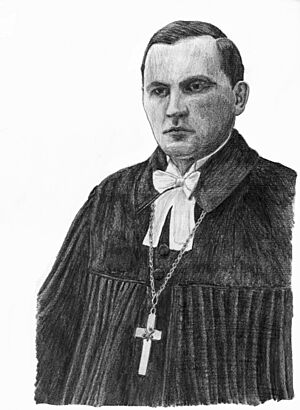Arthur Võõbus facts for kids
Arthur Vööbus (born April 28, 1909 – died September 25, 1988) was an important Estonian scholar. He studied old religious texts, especially from the Middle East, and wrote about church history. He was also a professor and a pastor.
Contents
His Life Story
Arthur Vööbus was born in a small village called Matjama in Estonia. His father was a teacher. Arthur finished high school in Tartu in 1928. Then, in 1932, he finished his studies at the University of Tartu, where he studied theology. Theology is the study of religious beliefs. That same year, he became a priest. From 1933 to 1940, he worked as a pastor in Tartu.
Early Studies and Research
In 1934, Arthur Vööbus earned a master's degree in theology. He wrote about the ideas of a philosopher named Soren Kirkegaard. At the same time, he traveled to big cities like Rome, Paris, London, and Berlin. He worked in libraries there, studying old religious texts written in Syriac. Syriac is an ancient language from the Middle East. He learned this language at the university.
In 1936, he married Ilse Luksep. Her family was wealthy, which helped him continue his important research. By the late 1930s, Vööbus was already publishing some of these old Syriac texts.
Escaping War
In 1940, the Soviet Union took over Estonia. Arthur Vööbus did not agree with this, so he escaped to Germany. He was even watched by the secret police there. When German troops later took over Estonia during World War II, Vööbus returned home. In 1943, he earned his doctorate degree from the University of Tartu. His studies focused on how monks lived in Syria, Mesopotamia, and Persia before the year 1000.
In 1944, the Soviet Union took over Estonia again. Arthur Vööbus and his family had to escape a second time. He spent some time in refugee camps. From 1944 to 1948, he worked as a pastor in these camps. He also taught church history at a university for refugees in Germany. When that university closed, he worked at the British Museum in London.
Life in America
In 1948, Vööbus moved to the United States. He became a professor at the Lutheran School of Theology at Chicago. He taught there from 1951 until he retired in 1977. Arthur Vööbus was part of many important scientific groups, like the Royal Academy of Science in Belgium. He passed away on September 25, 1988, in Oak Park, Illinois.
His Amazing Collection
During his career, Vööbus traveled to the Middle East more than 40 times. He was looking for old manuscripts, which are handwritten books. He took many photographs of these old texts on film. His collection of Syriac manuscript images was the largest of its kind before digital cameras existed.
This collection is now called the Vööbus Syriac Manuscript Collection. In 1979, it moved from his home to a special institute in Chicago. In 2016, the collection was moved to the Hill Museum & Manuscript Library (HMML). HMML is now working to digitize all the films. This means they are turning the film photos into digital images. In 2023, HMML made these scanned films available for everyone to see online at https://hmmlvoobus.org/.
Works
- Communism's Challenge to Christianity (1950)
- Studies in the History of the Gospel Text in Syriac (1951)
- History of Asceticism in the Syrian Orient (volumes 1–3, 1958, 1960, 1988)
- The Martyrs of Estonia: The Suffering, Ordeal and Annihilation of the Churches under the Russian Occupation (1984)
Images for kids



